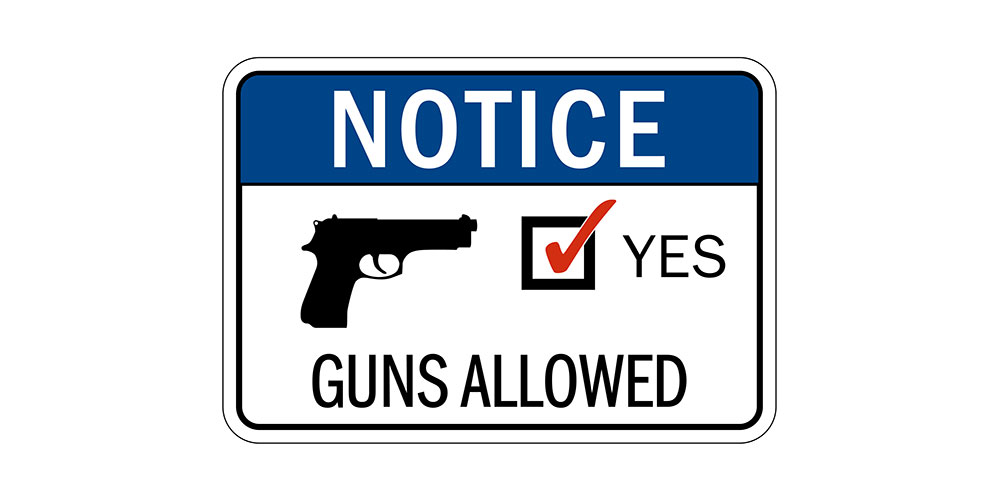Editor’s Note: This article, originally posted on 5/10/24, is not regularly updated. ALWAYS check with your state legislature or school district for the most up-to-date laws and policies.
In the span of one week last month, Tennessee and Iowa joined the growing list of states that allow trained school staff to carry guns on public school grounds.
The laws significantly vary from state to state. For many, it is up to individual school districts to decide if they want to allow non-security staff to carry guns. Some have restrictions on where and when guns can be concealed, and required training and permitting also vary.
Just 16 states and the District of Columbia have laws specifically prohibiting teachers from carrying guns, according to USA Today. However, even those laws can vary, as denoted in the list below:
- Alabama (some school administrators are allowed to have a firearm if they complete the state’s sentry program and there isn’t a school resource officer available)
- California
- Hawaii
- Illinois
- Maine (also prohibits guns for non-law enforcement school security)
- Maryland
- Nebraska (also prohibits guns for non-law enforcement school security)
- New Mexico
- New York
- North Carolina (also prohibits guns for non-law enforcement school security)
- North Dakota
- Rhode Island
- Virginia
- Washington
- West Virginia (also prohibits guns for non-law enforcement school security)
- Wisconsin (also prohibits guns for non-law enforcement school security)
While some states prohibit staff from carrying guns in schools, some allow members of the general public to carry if the individual has a concealed carry permit. This includes Kansas, Michigan, Mississippi, New Hampshire, Oregon, Utah, and Wyoming.
So how many states have laws permitting teachers to be armed? According to an analysis of state laws by Newsweek, more than 30 states allow teachers to carry guns under certain conditions. The majority requires at least the permission of a school authority and additional training. Here’s the breakdown with exceptions denoted.
States Where Teachers Can Carry Guns with Permission from School Authority
- Alaska
- Arizona (when used in a program approved by the school)
- Connecticut
- Delaware (need concealed carry permit)
- Georgia
- Idaho
- Indiana
- Iowa
- Kansas
- Kentucky
- Louisiana
- Massachusetts
- Michigan
- Minnesota
- Missouri
- Montana
- Nevada
- New Jersey
- Ohio
- Oregon (need concealed carry license)
- Pennsylvania (schools can apply to allow certain security personnel to carry firearms)
- South Carolina
- Texas (if board-approved as part of a Guardian Program or if the person is a designated school marshal)
- Utah (need a concealed carry permit)
- Vermont
States Where Teachers Can Carry Guns in Certain Circumstances and/or with Permits/Required Training
- Arkansas (prohibits teachers in public schools from carrying guns but allows exemptions for private schools)
- Colorado
- Florida (as part of the School Guardian Program)
- Mississippi (only if part of the Guardian Program)
- Oklahoma (only private schools)
- South Dakota (if the person is a school sentinel)
- Tennessee
- Wyoming (need valid concealed carry permit)
States Where Teachers Can Carry Guns with No Restrictions
- New Hampshire (only students are prohibited)
Making or Breaking the Case for Arming School Teachers
Proposed laws for arming teachers have historically been introduced following significant school violence events, including in Tennessee (Covenant School shooting) and Florida (Marjory Stoneman Douglas High School shooting). Proponents argue students and teachers are sitting ducks if an armed intruder enters a school, pointing to various studies that show it takes law enforcement anywhere from five to 10 minutes to respond to an emergency.
The FBI reports that 69% of active shooter threat events end in five minutes or less, with 67% over before officers arrive. For schools in rural areas, it can take police up to 20 minutes or longer to respond to an active shooter event.
“No one wants to imagine a scenario where teachers need to defend their students with firearms,” Isaiah Miller, a spokesperson for a large national firearm brand, wrote in an email to Campus Safety. “But the unfortunate reality is that school shootings are on the rise, and we must consider all lines of defense to keep children safe. Allowing trained teachers to carry concealed weapons could make a potential attacker think twice, as they won’t know who might be armed and ready to fight back. Comprehensive training programs can ensure participating teachers are prepared to handle crisis situations, even as we all hope and pray they never have to put those skills to use. Arming teachers, utilizing AI threat detection and tracking, and real-time video feeds and communication from schools to local law enforcement.”
Opponents argue arming teachers is an unfair responsibility to add to the plate of already overworked teachers, and that it is a significant insurance liability. For instance, Kansas allows school staff to carry guns in the classroom when specifically authorized in writing by the superintendent or chief administrator. EMC Insurance Companies, which covers most Kansas school districts, denied coverage to armed staff several years ago, according to the United States Concealed Carry Association.
Many also believe it will make students and staff less safe by increasing the likelihood of gun accidents in schools. According to a 2023 report from the Giffords Law Center to Prevent Gun Violence, in the last five years, there have been about 100 documented incidents of guns being mishandled, left in the reach of children, or accidentally discharged in schools. In March, Campus Safety reported that since December, there had been at least seven reports of an armed school security officer or law enforcement officer accidentally leaving their gun unattended in a school bathroom or other area on a K-12 campus.







